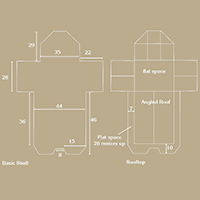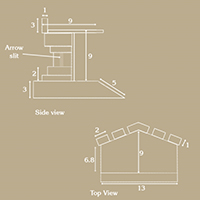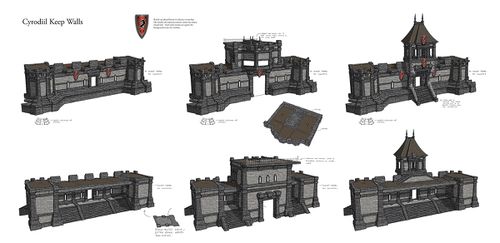General:Creating ESO: Cyrodiil's Keeps
The original article was posted here on December 20, 2013.
Three alliances clash in Cyrodiil. Fierce battles erupt around fortified keeps throughout the region as the Ebonheart Pact, Daggerfall Covenant, and Aldmeri Dominion struggle to conquer and control more territory. These keeps are critical to each side's war efforts, and when you venture into Cyrodiil, chances are you'll find yourself embroiled in the efforts to assault or defend them. In this Creating ESO, we're taking a closer look at these fortifications.
We couldn't jump right into building out keeps and creating art straight away. Though we had plans for how we wanted them to function, we needed to ensure we could meet the technical requirements for those ideas. Our designers worked with engineers to build a framework that could support the design goals—features like destructible keep walls, siege weapons, and large numbers of player characters on-screen had to be considered from both a technology and design standpoint.
After putting those building blocks in place, we began experimenting with keep layouts. We knew we wanted the battles to consist of multiple stages, allowing the attackers and defenders to each have several opportunities to turn the tide of a siege. We had to take combat into account, as well; everything could affect the fun of attacking and defending, from whether or not we'd have character collision (we currently do not) to what abilities players can utilize—knockbacks, gap closers, and area abilities in particular have a strong impact on how the assaults play out. Each of these factors, among others, helped to shape our keeps.
 |
At first, we tried some more traditional multi-floor constructions with secure interior rooms, but we found in testing that the bottlenecks created by stairs and small passageways didn't work well from a combat perspective. We always wanted an outer and inner keep (a facet of multi-stage fights), and we liked the idea of the battle getting tougher for the attacker the further they progressed, so we moved to a single-floor approach but provided locations in the inner keep where defenders can gain height advantage and rain down spells and arrows on the invaders.
Our designers pored through books with images of medieval fortifications for inspiration—not every keep is exactly the same, and these real-life examples helped us create buildings with some variety to their floor plans that made sense in the terrain. For instance, the large structures that guard Artifact Gates are different than the smaller outpost-style keeps, and the landscape around some keeps provides natural defense. For a victorious assault, you'll need to know what kind of fortifications you're up against and plan your approach carefully.
We also had to decide how attackers would claim a keep. We considered having a powerful NPC that invaders would need to defeat, but found that this took focus away from fighting enemy players—the assailants would group up and rush to the NPC, sometimes forgoing combat with other players in a mad dash to kill the keep's lord and gain control. A few iterations later, we came to our current system, where the attackers need to bust into the keep and occupy two flagged locations for a period of time to gain control of it, all the while facing down the defenders trying to drive them out.
Planning your assault will be important, especially for organized teams. You can bust down the front gate or blast through the outer walls, and then even the inner keep's walls can be destroyed, but you'll have to consider the amount of damage your alliance does to the structure. If you want, you can blow up all the walls and every door, leaving the defenders exposed, but be warned: when you claim the keep, that damage won't be instantly repaired. It takes resources to undo the destruction, and it can be costly to completely rebuild. We expect this economic impact will add another dimension to your alliance's battle plans—you're probably already realizing some of the implications!
At this point, we had many of the ingredients for great multi-stage sieges. An attacker will usually try to cut off the keep's supplies by claiming its resources first, then move on to an assault on the outer walls, break into the inner keep to occupy the flags, and drive out any remaining defenders. We knew how the most obvious tactics for assault and defense would work, but one of the most fun (and challenging) parts of designing large-scale PvP is figuring out in advance what kind of tactics players will employ as they gain mastery over the system. New strategies will emerge over time, and we need to be prepared for them. We already have some thoughts about what we'll see, and we're excited to find out what new battle plans will develop as we continue testing.
During early development, all of our keep layouts were built from simple geometry with no finished art (often referred to as "greybox"). We didn't want to create too much art before we had a good idea of what the buildings would look like. Our designers and artists spent a long time exploring Cyrodiil in Oblivion looking for inspiration. The Colovian architecture seen in several locations lent itself well to the strong, fortified structures we wanted to build. You'll probably recognize some of the locations and names if you spent time in Oblivion—some of the ruins you encounter in that game are still standing in the time of ESO.
Now, we're focusing on balancing. Cyrodiil is "always on;" you can go there at any time and try to take a keep. We need to set the strength of the defenses, coming up with a target for how many people are required to successfully claim a keep, and never forgetting that there will be teams who want to try and sneak in during less populated hours to grab territory.
We decided that we'd need NPC guards to help provide a minimum defense. They aren't unnecessarily powerful, but they can deter small groups from easily sieging a keep. The guards appear once a keep is claimed, which has the added benefit of giving the victorious assault party some backup and a chance to rest just a bit. Balancing their health and damage, along with the strength of walls and doors, continues to be adjusted through testing.
As you can see, keeps aren't as simple as they might appear on the surface, and we've put a great deal of effort and thought into their design. We think you'll really enjoy the fruits of that labor when you're out there with your allies, cheering after a hard-fought victory or planning a counterattack after being ousted from your own territory.
Thanks for joining us for this look at the creation of keeps. We can't wait to meet you on the battlefield. We'll have another Creating ESO for you before long, so come back soon for a new inside look at the development of The Elder Scrolls Online.





